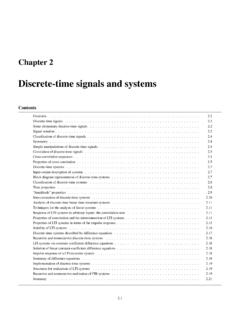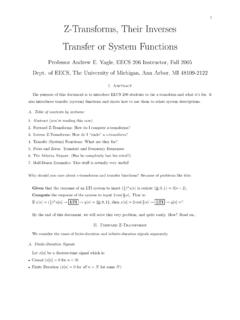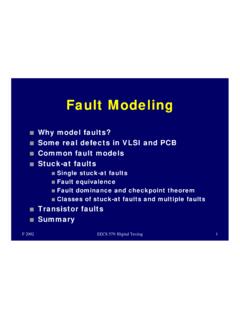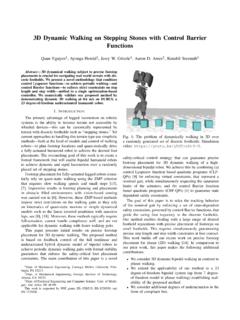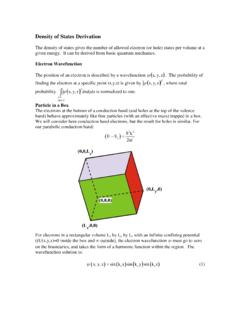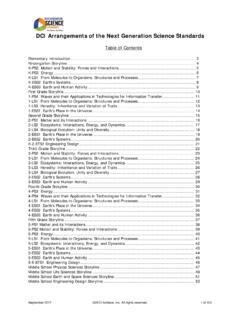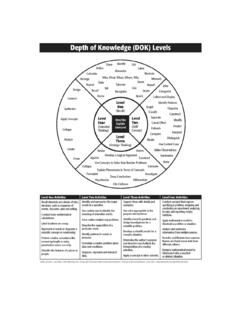Transcription of Database Modeling and Design
1 1 Database Modeling and Design3rd EditionToby J. TeoreyUniversity of MichiganLecture NotesContentsI. Database Systems and the Life Cycle (Chapter 1)..2 Introductory concepts; objectives of Database management 2 Relational Database life cycle 3 Characteristics of a good Database Design process 7II. Requirements Analysis (Chapter 3)..8 III. Entity-Relationship (ER) Modeling (Chapters 2-4)..11 Basic ER Modeling concepts 11 Schema integration methods 22 Entity-relationship 26 Transformations from ER diagrams to SQL Tables 29IV.
2 Normalization and normal forms (Chapter 5)..35 First normal form (1NF) to third normal form (3NF) and BCNF 353NF synthesis algorithm (Bernstein) 42 Fourth normal form (4NF) 47V. Access Methods (Chapter 6)..50 Sequential access methods 50 Random access methods 52 Secondary Indexes 58 Denormalization 62 Join strategies 64VI. Database Distribution Strategies (Chapter 8)..66 Requirements of a generalized DDBMS: Date s 12 Rules 68 Distributed Database requirements 72 The non-redundant best fit method 74 The redundant all beneficial sites method 77 VII.
3 Data Warehousing, OLAP, and Data Mining (Chapter 9)..79 Data warehousing 79On-line analytical processing (OLAP) 86 Data mining 93 Revised 11/18/98 modify Section VRevised 11/21/98 insertions into Section VIIR evised 1/14/99 modify Section VIRevised 2/11/99 modify Section IV, 4NF ( FD, MVD mix)Revised 6/13/00 modify Section V (secondary indexes)2I. Database Systems and the Life CycleIntroductory Conceptsdata a fact, something upon which an inference is based (information or knowledge hasvalue, data has cost)data item smallest named unit of data that has meaning in the real world (examples: lastname, address, ssn, political party)data aggregate (or group) -- a collection of related data items that form awhole concept; a simple group is a fixed collection, date (month, day, year).
4 Arepeating group is a variable length collection, a set of group of related data items treated as a unit by an application program (examples:presidents, elections, congresses)file collection of records of a single type (examples: president, election) Database computerized collection of interrelated stored data that serves the needs ofmultiple users within one or more organizations, interrelated collections of recordsof potentially many types. Motivation for databases over files: integration for easy accessand update, non-redundancy, management system (DBMS) -- a generalized software system formanipulating databases.
5 Includes logical view (schema, sub-schema), physical view(access methods, clustering), data manipulation language, data definition language, utilities- security, recovery, integrity, administrator (DBA) -- person or group responsible for the effective use ofdatabase technology in an organization or enterprise. Motivation: control over all phases ofthe of Database Management1. Data availability make an integrated collection of data available to a wide variety ofusers* at reasonable cost performance in query update, eliminate or control dataredundancy* in meaningful format data definition language, data dictionary* easy access query language (4GL, SQL, forms, windows, menus);embedded SQL, etc.
6 ; utilities for editing, report generation, sorting2. Data integrity insure correctness and validity* checkpoint/restart/recovery* concurrency control and multi-user updates* accounting, audit trail (financial, legal)3. Privacy (the goal) and security (the means)* schema/sub-schema, passwords4. Management control DBA: lifecycle control, training, maintenance35. Data independence (a relative term) -- avoids reprogramming of applications, allowseasier conversion and reorganization* physical data independence program unaffected by changes in the storage structure oraccess methods* logical data independence program unaffected by changes in the schema* Social Security Administration example (1980 s)- changed benefit checks from $ to $ format- had to change 600 application programs- 20,000 work hours needed to make the changes (10 work years)
7 * Student registration system cannot go to a 4-digit or hexadecimal course numberingsystem because of difficulty changing programs*Y2K (year 2000) problem many systems store 2-digit years ( 02-OCT-98 ) in theirprograms and databases, that give incorrect results when used in date arithmetic (especiallysubtraction), so that 00 is still interpreted as 1900 rather than 2000. Fixing this problemrequires many hours of reprogramming and Database alterations for many companies andgovernment Database Lifecycle1.
8 Requirements formulation and analysis* natural data relationships (process-independent)* usage requirements (process-dependent)* hardware/software platform (OS, DBMS)* performance and integrity constraints* result: requirements specification document, data dictionary entries2. Logical Database ER Modeling (conceptual Design ) View integration of multiple ER Transformation of the ER model to SQL Normalization of SQL tables (up to 3NF or BCNF)*result: global Database schema, transformed to table definitions3.
9 Physical Database Design * index selection (access methods)* clustering4. Database distribution (if needed for data distributed over a network)* data fragmentation, allocation, replication5. Database implementation, monitoring, and modification4567 Characteristics of a Good Database Design Process* iterative requirements analysis- interview top-down- use simple models for data flow and data relationships- verify model* stepwise refinement and iterative re- Design * well-defined Design review process to reduce development costs review team - Database designers-DBMS software group-end users in the application areas when to review - after requirements analysis & conceptual Design - after physical Design - after implementation
10 (tuning) meeting format- short documentation in advance- formal presentation- criticize product, not person- goal is to locate problems, do solutions off line- time limit is 1-2 hours8II. Requirements AnalysisPurpose - identify the real-world situation in enough detailto be able to define Database components. Collect two types of data: natural data (input to thedatabase) and processing data (output from the Database ).Natural data requirements (what goes into the Database ) objectives - sell more cars this year- move into to recreational vehicle system objectives- keep track of competitors products and prices- improve quality and timing of data to management regarding production schedule delays, keep track of vital resources needed to produce and market a and operational policies- annual review of employees- weekly progress reports- monthly inventory check- trip expense elements, relationships, constraints.
